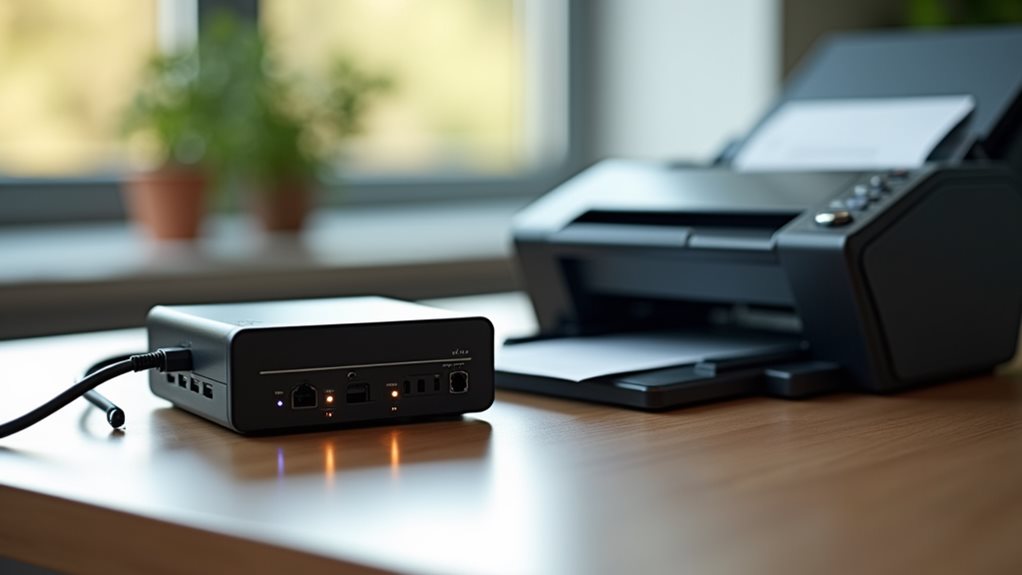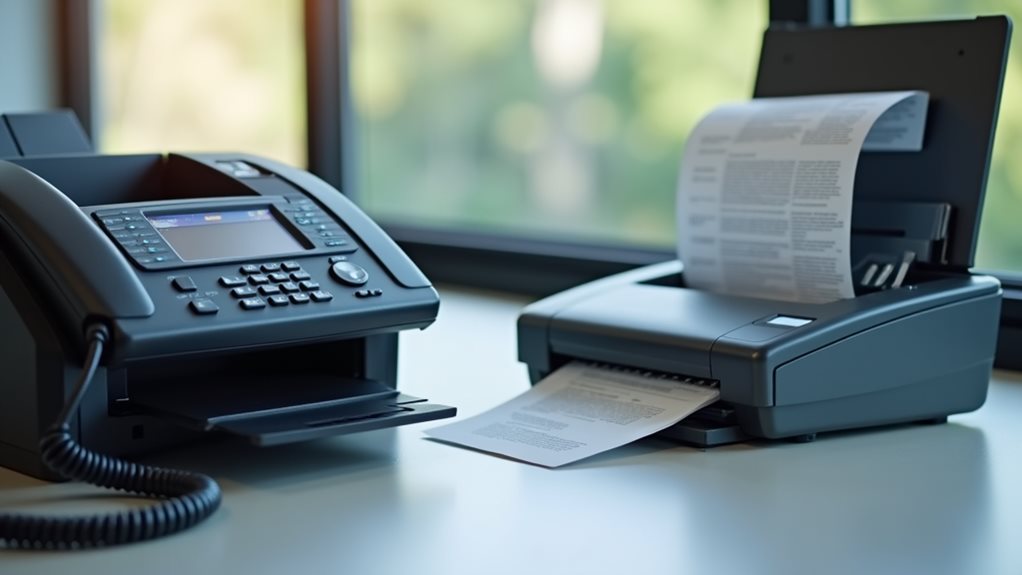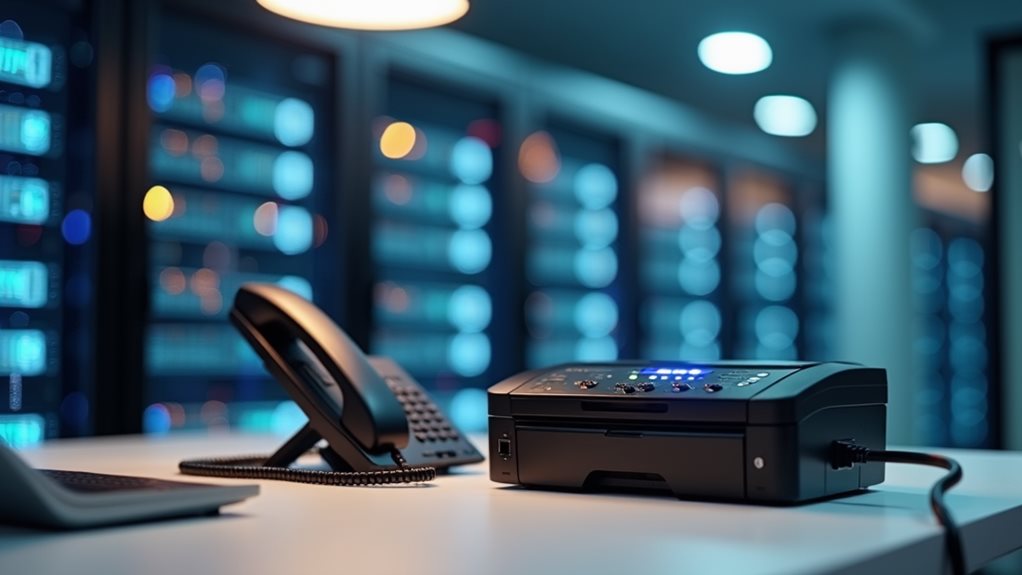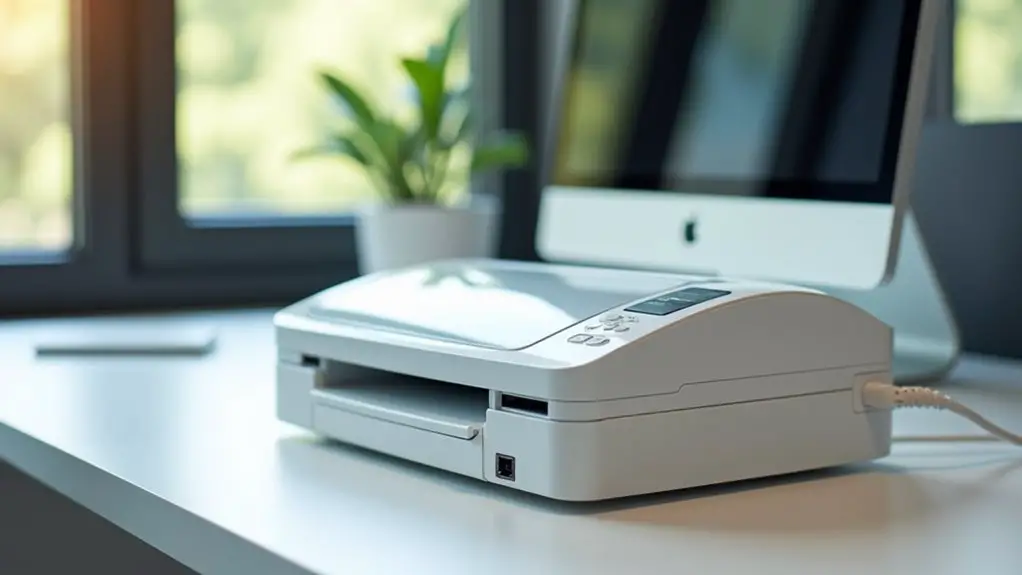VoIP faxing converts traditional fax signals into digital data packets for transmission over Internet Protocol networks. You'll benefit from this technology by sending and receiving faxes directly through email or digital platforms using the T.38 protocol, which bridges analog and digital communications. The system requires specific components like a T.38-compatible gateway and ATA device to function properly. You'll save considerably on hardware costs while gaining enhanced security through encryption and digital archiving capabilities. By eliminating dedicated phone lines and integrating with existing communication systems, VoIP faxing streamlines your document transmission processes. The following sections explore the technical specifications and implementation strategies in detail.
Understanding VoIP Faxing Technology
While traditional faxing relies on analog phone lines, VoIP faxing transforms the process by converting analog fax signals into digital packets for transmission over IP networks. This conversion represents one of the most significant VoIP technology trends, enabling businesses to streamline their communication infrastructure while maintaining fax capabilities. The adoption of VoIP faxing helps organizations achieve significant cost savings through reduced equipment and maintenance expenses. However, minor packet loss can cause complete transmission failures during fax attempts. Notably, SIP trunking technology enhances the overall communication efficiency by allowing multiple concurrent calls.
At the core of this digital communication advancement is the T.38 protocol, which serves as the bridge between old and new technologies. When you send a fax through VoIP, your document's analog signals are converted into digital data packets by an Analog Telephone Adapter (ATA) or T.38 gateway.
These packets travel across the internet to their destination, where they're reassembled and converted back into analog signals for the receiving fax machine. Additionally, using geographic number flexibility in your VoIP setup can further enhance customer accessibility.
You'll need specific technical components to guarantee successful transmission: a T.38-compatible gateway, an ATA device, and appropriate FoIP server software.
The system operates through a fax relay method, which breaks down your fax information into manageable packets. This process requires both sending and receiving devices to support VoIP protocols, creating a seamless bridge between traditional faxing and modern digital networks.
Key Benefits of VoIP Faxing
You'll find significant cost advantages when adopting VoIP faxing, as it eliminates the need for dedicated hardware while reducing expenses associated with traditional fax operations. By utilizing VoIP technology, businesses can further streamline their communication processes and reduce overall costs.
The technology's digital storage capabilities provide instant access to archived documents and seamless integration with existing business software systems for improved workflow efficiency. Email-based faxing allows you to send documents directly from your inbox without requiring a physical fax machine. The integration with Unified Communications systems enables streamlined collaboration across multiple communication channels.
Your sensitive documents remain protected through advanced encryption protocols and secure transmission methods, ensuring confidentiality while maintaining compliance with industry standards.
Cost Savings Through Technology
Organizations seeking to modernize their communication infrastructure can achieve substantial cost savings by shifting to VoIP fax technology. Your cost reduction strategies begin with the elimination of traditional fax hardware, including dedicated machines, maintenance requirements, and ongoing supplies like toner and paper.
These technology investments deliver immediate returns through reduced operational expenses. The implementation also provides enhanced security features for protecting sensitive document transmissions. Monthly subscription costs for VoIP fax services range from $9 to $35. Additionally, the use of the T.38 protocol for reliable fax transmission ensures high-quality communication.
You'll notice significant savings through the elimination of dedicated phone lines and long-distance charges traditionally associated with fax communications. By leveraging your existing internet infrastructure, you can streamline your communication costs while maintaining robust fax capabilities.
The scalability of VoIP fax solutions allows you to add or remove users without incurring substantial hardware expenses.
Your operational efficiency will improve through digital fax management and integration with existing software systems like CRM and EMR platforms. You can send and receive faxes from any location with internet access, eliminating the need for physical document handling.
This digital transformation reduces waste, increases productivity, and provides faster, more reliable fax transmissions. The result is a more cost-effective, flexible communication solution that adapts to your organization's growing needs while minimizing infrastructure investments.
Digital Storage And Access
Beyond the immediate cost benefits, VoIP fax technology revolutionizes document storage and accessibility through advanced digital management protocols. Your documents are automatically encrypted and stored in secure cloud servers, guaranteeing both protection and instant accessibility from any internet-connected device. Virtual fax hubs enable streamlined document organization in one centralized location. The system employs Session Initiation Protocol (SIP) to ensure reliable communication for fax transmissions.
The system's digital organization capabilities streamline your workflow by delivering faxes directly to your email inbox as digital files. You'll have immediate access to your documents without the need for physical storage or manual processing. The elimination of traditional landline connections significantly reduces infrastructure costs while maintaining reliable service.
Point-to-point encryption safeguards your sensitive information while enabling seamless document sharing and archiving through cloud-based solutions. Document accessibility reaches new heights as you can retrieve, process, and manage faxes from anywhere at any time.
The technology integrates effortlessly with your existing email systems and office workflows, eliminating the constraints of traditional fax infrastructure. You're able to track, organize, and distribute documents more efficiently while maintaining secure, encrypted storage protocols.
This digital transformation guarantees your faxed documents remain protected, searchable, and instantly available when needed, fundamentally enhancing your organization's document management capabilities.
Enhanced Security Features
Through advanced encryption protocols, VoIP fax technology delivers unprecedented security features that fortify your document transmission process.
You'll benefit from point-to-point encryption, Transport Layer Security (TLS), and Secure Sockets Layer (SSL) protocols that establish secure transmission channels between endpoints. These secure faxing protocols guarantee your sensitive documents remain protected from unauthorized access and interception. Regular audits help maintain the highest level of security compliance and performance. Additionally, it's crucial to understand that VoIP systems are frequently targeted by cyber threats, making enhanced security measures essential for any business.
Your fax transmissions gain additional protection through end-to-end encryption methods, incorporating Secure/Multipurpose Internet Mail Extensions (S/MIME) for email-based faxing. Modern VoIP fax solutions leverage packet-switching technology to transmit data more efficiently than traditional fax methods.
The system implements pre-shared keys between senders and recipients, while advanced cryptographic techniques maintain data integrity throughout the transmission process.
You can further enhance security by utilizing Virtual Private Networks (VPNs) that create encrypted tunnels for your fax data.
This infrastructure reduces reliance on traditional public switched telephone networks (PSTN), minimizing exposure to potential vulnerabilities.
Your fax data is stored on secure servers with military-grade encryption, guaranteeing compliance with regulatory requirements.
The combination of robust transmission protocols and encrypted storage provides you with a thorough security solution that surpasses traditional faxing methods while maintaining seamless accessibility and reliability.
How VoIP Fax Works

The transmission of fax data over VoIP networks relies on a sophisticated protocol-driven process that converts analog signals into digital packets. When you send a fax through VoIP, your system employs specific fax transmission protocols, primarily T.38, to manage the conversion and delivery of your documents.
Here's how the process works: Your fax machine's analog signals are first captured and encoded into digital format. The T.38 protocol then compresses this digital data and segments it into smaller packets that can efficiently travel across the internet.
You'll find that these packets follow optimized routes to reach their destination, where they're reassembled in the correct sequence.
At the receiving end, you'll need compatible equipment that can process these digital packets. Your system will decode the incoming data and convert it back into a format that the receiving fax machine can interpret.
If you're using a traditional fax machine with VoIP, you'll need either a T.38 gateway or an Analog Telephone Adapter (ATA) to bridge the digital-analog gap. This digital data conversion process guarantees that your faxes maintain their quality while benefiting from the cost-effectiveness and efficiency of VoIP technology. VoIP technology is efficient, allowing for lower costs compared to traditional fax methods.
Setting Up VoIP Fax Service
To set up VoIP fax service effectively, you'll need to select a provider that offers T.38 protocol support and matches your organization's fax volume requirements.
You must configure your network with proper QoS settings, adequate bandwidth, and compatible ATA devices or integrated access equipment for successful fax transmission.
Before launching your VoIP fax system, you should conduct thorough connectivity tests using test fax numbers and verify email-to-fax functionality if your service includes this feature. Additionally, ensuring the implementation of robust security measures is essential to protect sensitive communications during fax transmission.
Choose Right Service Provider
Selecting a suitable VoIP fax service provider requires systematic evaluation of your organization's specific requirements and the provider's capabilities. Your provider selection process should start with a thorough assessment of your business needs, including call volume, scalability requirements, and integration needs.
During feature comparison, focus on providers offering military-grade encryption, reliable network infrastructure, and extensive support options that align with your operational demands.
When evaluating potential providers, you'll need to verify their compliance with relevant regulations, especially if you're handling sensitive data requiring HIPAA compliance. Consider their track record for uptime, redundancy measures, and ability to scale with your business growth.
- You'll protect your organization's reputation by choosing a provider with proven security protocols and documented compliance certifications.
- You'll save significant resources by selecting a provider whose pricing structure matches your usage patterns.
- You'll enhance team productivity with providers offering seamless integrations with your existing business tools.
- You'll future-proof your investment by choosing a provider with scalable infrastructure and flexible service plans.
- Additionally, ensure that the provider offers high uptime guarantees to maintain reliable service and minimize disruptions.
Focus on providers offering extensive mobile support, automated fax routing, and the ability to port existing fax numbers without additional fees.
Configure Network Requirements
Successful VoIP fax implementation starts with proper network configuration that meets specific technical requirements. You'll need to ascertain your broadband connection provides sufficient bandwidth, with at least 88kbps dedicated to fax transmission.
Start by configuring your network hardware, including VoIP phones, PBX systems, and Ethernet switches to support IP communication. For peak network reliability, you must configure your VoIP fax line settings correctly. Set your connection to use non-compressed codecs like G.711, μ-law, or A-law.
Remove any DSL filters from the line and disable silence suppression features. Configure your fax machine's FXO as the primary device on the phone line to minimize interference.
Your fax machine requires specific settings for VoIP compatibility. Enable VoIP mode if available, or use Overseas mode as an alternative. Disable ECM and set the baud rate to 9600bps for improved stability.
Connect an ATA to bridge your analog fax machine with the VoIP network. If you're implementing T.38 protocol, verify compatibility with your service provider to ascertain seamless fax transmission across the IP network. Additionally, ensure that your network supports the Quality of Service (QoS) to prioritize fax traffic for uninterrupted communication.
Test Fax Connectivity
Prior to sending your first VoIP fax, thorough testing guarantees proper connectivity and configuration. You'll need to adjust transmission settings and verify fax machine compatibility with your VoIP setup. Start by configuring your device to use the G711 codec and setting the BAUD rate to 9600 bps or lower. Ascertain your fax machine connects properly to the ATA's IN-Line port and verify you're getting a clear dial tone.
- Test your line connection using an analog phone to confirm proper signal transmission.
- Verify your fax machine's resolution is set to Standard for ideal packet handling.
- Adjust transmission speed to the lowest setting to ascertain successful delivery.
- Check that ECM is disabled to minimize transmission complications.
For ideal performance, connect your power adapter directly to a wall socket and implement QOS settings to prioritize fax traffic.
If you're experiencing connectivity issues, consider using a reverse DSL filter between your ATA and fax machine. Monitor your internet bandwidth to ascertain it meets VoIP faxing requirements.
If problems persist after implementing these technical adjustments, contact your VoIP provider for additional configuration support.
Common VoIP Faxing Challenges

VoIP faxing frequently encounters considerable technical challenges that can impact transmission reliability and quality.
When you're sending faxes over VoIP, you'll face bandwidth constraints as fax transmissions require at least 88kbps – double what typical VoIP calls need. You can't compress analog fax tones like regular voice data, which demands a full 64Kbps data stream plus additional overhead from IP packets.
Protocol compatibility presents another major hurdle. Your fax machines use T.30, T.38, and G.711 protocols, while VoIP systems typically operate on G.729. If you don't have T.38 support on both network ends, you'll experience transcoding issues and potential disconnections.
Network conditions also considerably affect fax transmission reliability. You'll notice that packet loss, delay, and jitter can disrupt or completely fail your fax transmissions, especially during peak hours when network congestion is high. Understanding VoIP technology is crucial for troubleshooting these issues effectively.
To address these challenges, you might need to maintain a traditional POTS line for critical faxing needs or consider digital fax alternatives.
While VoIP faxing offers cost benefits, its inherent technical limitations and reliability issues make it problematic for high-volume faxing environments.
Traditional Vs Voip Faxing
Understanding the key differences between traditional and VoIP faxing helps address many of the technical challenges previously discussed. The communication evolution from analog to digital has transformed fax technology, creating a more versatile and cost-effective solution.
While traditional faxing relies on dedicated phone lines and physical machines, VoIP faxing leverages your existing internet infrastructure to transmit documents digitally.
- You'll eliminate costly hardware maintenance and dedicated phone lines, reducing your operational expenses by up to 80%
- You'll gain the freedom to send and receive faxes from anywhere with an internet connection, boosting your productivity
- You'll benefit from direct-to-email delivery, guaranteeing you never miss important documents
- You'll contribute to environmental sustainability by reducing paper waste and energy consumption
The T.38 protocol guarantees reliable VoIP fax transmission, though you'll need sufficient bandwidth and a stable internet connection.
While traditional faxing offers consistent quality through analog signals, VoIP faxing provides superior flexibility and integration capabilities.
Your choice between these technologies should consider your business requirements, internet infrastructure, and security needs.
Remember that VoIP faxing's packet-loss sensitivity can be mitigated through proper network configuration and quality of service settings.
Best Practices for VoIP Faxing

Through careful implementation of proven protocols and settings, successful VoIP faxing requires adherence to specific technical guidelines. To enhance your VoIP fax system, you'll need to configure several critical components according to industry best practices.
Start by setting up your fax machine with an ATA connection and implementing the T.38 protocol, which is essential for real-time fax transmissions over IP networks. You should configure your system to use the G711 codec for enhanced compatibility. For fax enhancement, lower your baud rate to 9600 and disable ECM to improve transmission success rates.
Test your setup using diagnostic tools and free test fax numbers, such as HP's 1-888-473-2963. Pay close attention to your network quality metrics, as minimizing packet loss, latency, and jitter directly impacts fax reliability. If you're experiencing persistent issues, review your VoIP provider's specific instructions, as they may offer customized settings for enhanced performance.
When dealing with critical documents, consider implementing a unified communications platform to streamline your fax operations.
Monitor your system's performance regularly and adjust settings as needed to maintain enhanced transmission success rates.
Security and Privacy Considerations
Since security breaches in fax transmissions can expose sensitive data, implementing robust protection measures is crucial for VoIP fax systems.
You'll need to prioritize data encryption through protocols like TLS and S/MIME, while utilizing secure FoIP services to prevent unauthorized access. Implementing point-to-point encryption guarantees your fax data remains protected from sender to recipient, particularly when transmitting over IP networks.
- Your sensitive healthcare information could be compromised if you don't maintain HIPAA compliance.
- Your business reputation might suffer irreparable damage from a single security breach.
- Your clients' personal data could fall into criminal hands through man-in-the-middle attacks.
- Your company might face severe legal consequences if private information is intercepted.
To strengthen your VoIP fax security, you should deploy Virtual Private Networks (VPNs) and maintain regular security updates.
Consider integrating advanced encryption methods like PKI while verifying your fax systems don't retain sensitive data in their memory.
When transmitting faxes, avoid using public internet connections and opt for private networks instead.
Always verify that your FoIP solutions incorporate secure protocols and comply with relevant regulations to protect against potential threats.
Frequently Asked Questions
Can Voip Fax Services Handle International Faxing?
You'll find VoIP fax services can handle international faxing protocols, but you need a compatible provider and stable connection. While VoIP fax advantages include cost savings, international transmissions may face geographical and technical restrictions.
What Happens to Voip Faxes During Power Outages?
During power outages, you'll lose VoIP fax functionality unless you've installed power backup solutions. To maintain fax reliability, you'll need UPS systems, battery backups, or cloud-based alternatives for your VoIP fax equipment.
Are There Specific File Size Limits for Voip Faxing?
You'll typically encounter a 5 MB file size limit for VoIP faxes. To maintain fax quality and guarantee successful transmission, split larger documents into smaller segments or compress files before sending your transmission.
Do Voip Fax Numbers Appear Different to Recipients?
No, VoIP fax numbers look identical to traditional fax numbers when you receive them. You'll experience the same transmission process, with added VoIP faxing benefits like enhanced security through T.38 protocol and encrypted delivery.
Can Multiple Users Share the Same Voip Fax Number?
Yes, you can share VoIP fax numbers among multiple users. Configure shared access through your service provider and set specific user permissions to control who can view, send, and manage faxes within your organization.
Final Thoughts
VoIP faxing offers you a protocol-driven alternative to traditional fax machines, integrating seamlessly with your existing IP infrastructure. You'll find it eliminates hardware costs while providing enhanced security through encryption protocols. To maximize your VoIP fax efficiency, you'll need to maintain sufficient bandwidth, implement T.38 protocol standards, and regularly monitor transmission quality. When properly configured, you're getting a scalable, cost-effective solution that streamlines your document transmission workflow.

